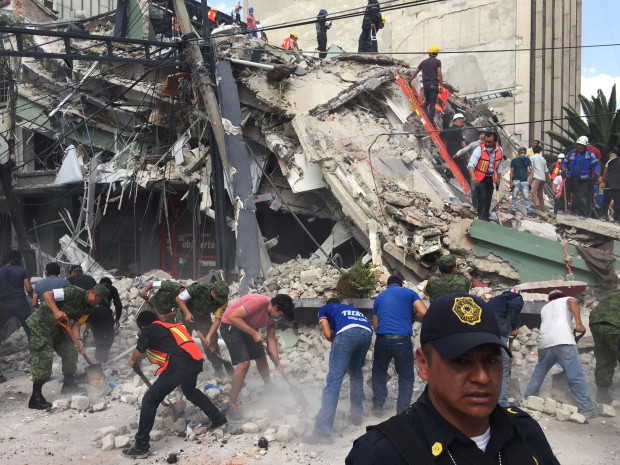An earthquake hit central Mexico on September 19th, killing over 300 people.
The earthquake measured 7.1 on the Moment Magnitude Scale, and its epicenter was south of the city of Puebla, southeast of Mexico City (see map here).
This earthquake hit on the 32nd anniversary of the Mexico City earthquake of 1985, which killed about 10,000 people, although the exact tally is unknown and much disputed.
For more on the 1985 earthquake, see my previous article Remembering Mexico City’s Devastating Earthquake of 1985.
After the 1985 earthquake, several changes were made to be better prepared for future quakes.
An earthquake can’t be prevented, but preparations can be made which increase the ability of more people to survive.

People search for survivors in a collapsed building in the Roma neighborhood of Mexico City, Tuesday, Sept. 19, 2017. (AP Photo/Enric Marti)
Earthquake drills are held in Mexico City every September 19th, on the anniversary of the 1985 quake.
A sophisticated early warning system was instituted, known as SASMEX, an acronym for Sistema de Alerta Sísmica Mexicano (Mexican Seismic Alert System). SASMEX is operated by CIRES, the acronym for Centro de Instrumentación y Registro Sísmico, A.C. (Center for Seismic Instrumentation and Registry), a civil association.
The SASMEX system now has around 100 sensors, on the Pacific Coast, in the mountains of Guerrero, and in the states of Puebla and Oaxaca.
The SASMEX system is linked directly to the public via Twitter, where the user can be informed of earthquakes and drills.
With the arrival of September 19, 2017, the thirty-second anniversary of the 1985 earthquake, a usual drill was held in Mexico City. And then, several hours later, the real earthquake hit.
The SASMEX early warning system kicked in, giving the people in Mexico City just twenty seconds warning before the quake struck. That might not sound like much, but if you can get people out of a building, or at least have them get under a table, more can be saved.
Somebody in Mexico City put together a short (6:42 minute) but fascinating video, entitled Terremoto en México Recopilación de videos 19 de Septiembre 2017. I showed it to my students in Spanish class.
It’s not a news media video but a compilation of shorter videos, taken by regular people in Mexico City with cell phones. You can see buildings falling, an apartment shaking, an explosion and even the strong waves in a Xochimilco canal (with a cameo appearance by gringo tourists in a boat). You get an unfiltered view of the devastation of an earthquake. No commentary is necessary.
Somebody put these shorter videos together into one, added dramatic music and uploaded it. It went viral and probably has over two million views by now.
Just watching the video gives one a feel for the power and devastation of an earthquake. Click here to view the video.
After the quake, rescue operations have been carried out both by professionals and citizen volunteers, their hard work and heroic efforts have saved many.
Why is Mexico City so earthquake-prone?
For one thing, it’s the tectonic plates, the North America plate and the Cocos plate sliding under it, which affect the entire region.
But Mexico City, particularly, has another exacerbating factor which makes the quakes more destructive.
Mexico City, founded in 1325 as Tenochtitlan by the Aztecs on an island in a lake in a valley, has expanded through the centuries, draining most of the lake and filling most of the valley with the city.
As a New York Times article explains it, “… much of the city stands on layers of sand and clay — up to 100 yards deep — that used to be under the lake. These soft, water-laden sediments make the city uniquely vulnerable to earthquakes and other problems. During an earthquake, the looser sediments near the surface cause shock waves to slow down from about one and a half miles per second to about 150 feet per second as they enter the valley. The slower waves grow in amplitude, similar to a tsunami approaching a coastline, and cause more violent shaking. Worse still, the denser, deeper material below the looser sediments causes waves to linger in the valley, making the amplified shaking last longer.”
If you are interested, click here for another New York Times article with various photographs, showing both the devastation and the rescue efforts.
If you would like to help earthquake victims in Mexico, you can go to this article which offers several options, and there you can click an option and give online. Click here to begin.
By Allan Wall for TYT
————
Allan Wall, an educator, resided in Mexico for many years. His website is located at http://www.allanwall.info.


